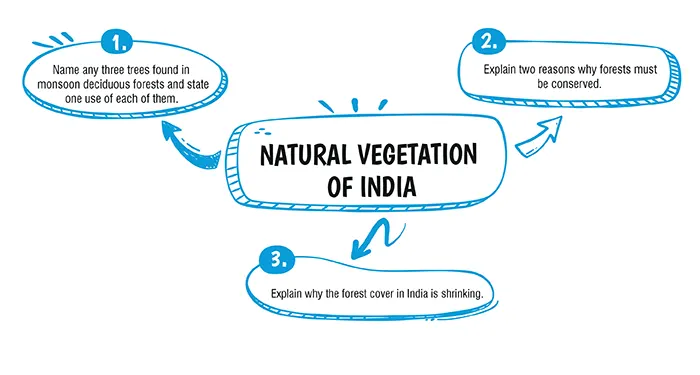Table of Contents

Ans. (b) 100 cm
Explanation:
Cinchona is a genus of flowering plant mostly used as a medicinal plant because of the quinones present in it. These are found in the areas where the rainfall is above 100 cm
Ans. (C) Tidal forests
Explanation:
Littoral Forests are also called Littoral and Swamp Forests and also Wetlands Forests.
Explanation:
1. Sal – used for making furniture, railway sleepers.
2. Sandalwood – used for extracting sandalwood and making oil, handicrafts and perfumes.
3. Mulberry – used for rearing silkworms.
Explanation:
Reasons why forests must be conserved are :
1. Forests must be conserved because they are the storehouse of timber and used for house making and furniture, fuel, fodder, etc.
2. They prevent soil erosion as the roots of the trees hold the soil together and help in preventing floods.
Explanation:
Forest cover in India is shrinking for the following reasons :
(i) Increasing urbanisation and industrialization is an important cause of degradation in forest areas.
(ii) Construction of hydroelectric projects have caused submergence of forest areas.
(iii) Human activities like mining, quarrying and building have resulted in deforestation at a large scale.
(iv) Growing demand for agricultural land with growing population and demand for food products has caused considerable shrinkage in forest areas.
Download Mind Map of this chapter
Download NowWant to Practice Mock Tests of this chapter
Practice NowDownload Important Questions of this chapter
Download Now| Chapter No. | Chapter Name |
|---|---|
| Chapter 1 | Map Study: Interpretation of Topographical Maps |
| Chapter 2 | Map of India |
| Chapter 3 | Location, Extent and Physical features |
| Chapter 4 | Climate of India |
| Chapter 5 | Soil Resources |
| Chapter 6 | Natural Vegetation of India |
| Chapter 7 | Water Resources |
| Chapter 8 | Mineral and Energy Resources |
| Chapter 9 | Agriculture In India |
| Chapter 10 | Industries in India: Agro Based |
| Chapter 11 | Industries in India: Mineral Based |
| Chapter 12 | Transport in India |
| Chapter 13 | Waste Generation and Management |
CBSE Important Questions Class 10
ICSE Important Questions Class 10
CBSE Important Questions Class 10
ICSE Important Questions Class 10